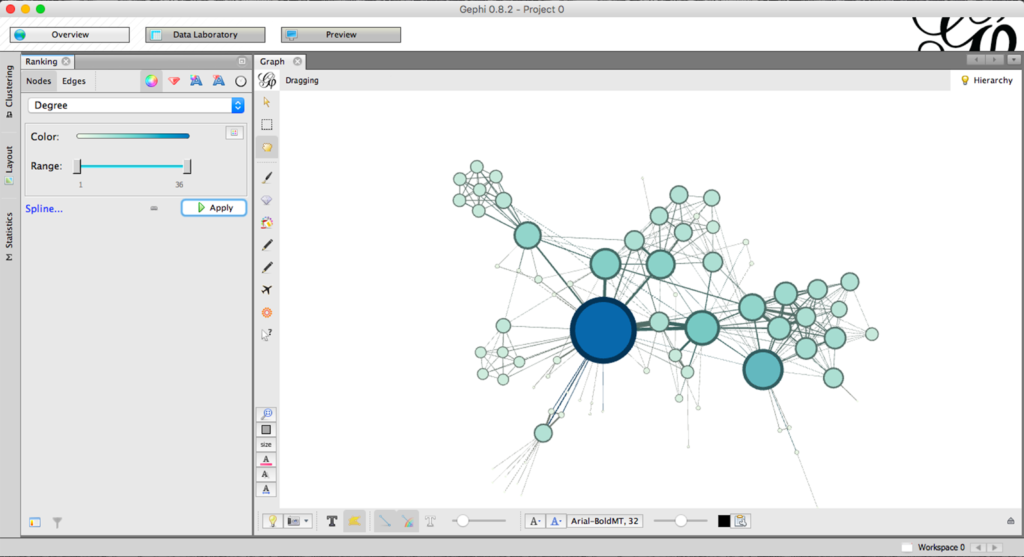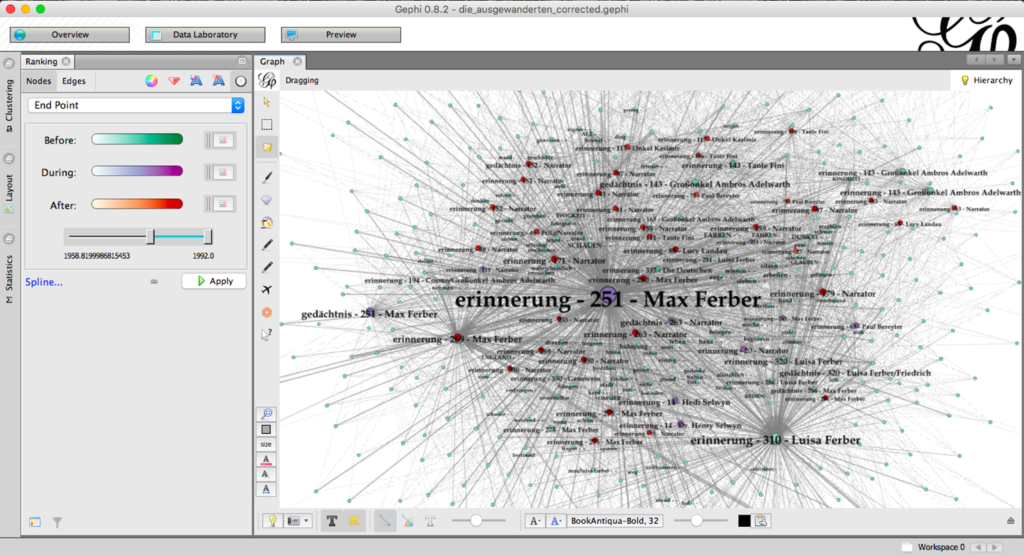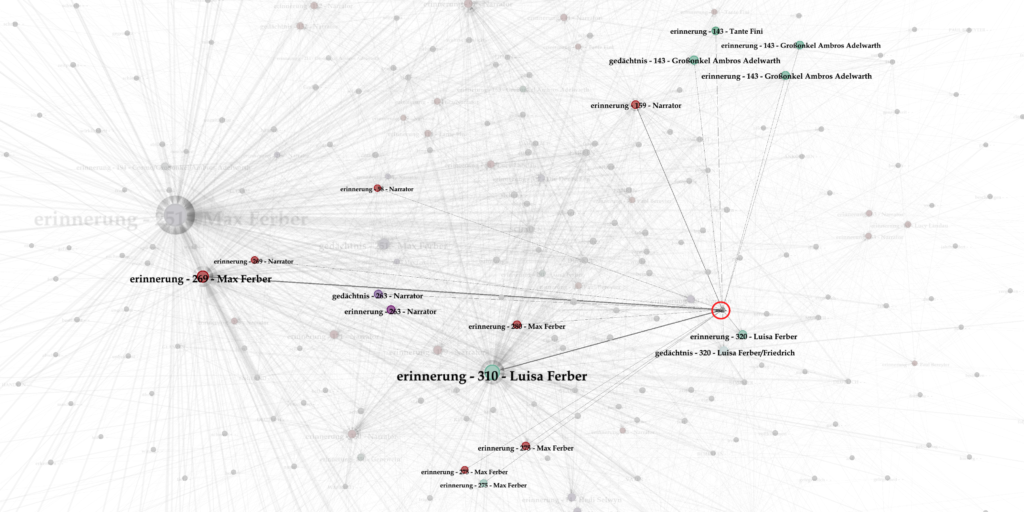PROJECT TWO: Patterns of the Anthemion Discovering Networks of Coincidence in W.G. Sebald’s Die Ausgewanderten
David D. Kim and Mark J. Phillips
PROLEGOMENON: Distant Reading and Computational Networking in German Studies
PROJECT ONE: WorldLiterature@UCLA: Tracking International Publics with Goethe
PROJECT TWO: Patterns of the Anthemion: Discovering Networks of Coincidence in W.G. Sebald’s Die Ausgewanderten
Acknowledgements
We thank the two anonymous reviewers for their incisive intervention in our essay. Mark Phillips also wishes to thank Matthew Handelman and Elizabeth Mittman—members of his A.M. thesis committee, along with David D. Kim—for their valuable feedback on an early and quite different version of this project.
In a 1992 interview with Piet de Moor, W.G. Sebald stated the following when asked about the role of coincidence in his fictional work:
In jedem Lebenslauf gibt es sehr unwahrscheinliche Zufälle, […] die nicht mit dem Verstand zu erklären sind. Ich glaube, wir neigen dazu, das alles zu übersehen und zu vergessen. Unsere Bemühungen, retrospektiv die Historiographie eines einzelnen Lebenslaufs zu rekonstruieren, sind willkürliche Versuche, Logik in diese Unordnung zu bringen (2012, 74-75).
According to Sebald, history was commonly written in accordance with a logic that ignored chance occurrences. To write the history of an individual life story was to dispel any confusion or disorder in retrospect. It was against the backdrop of this deliberate and dominant tendency that Sebald understood coincidence—especially improbable coincidence—to be a central topos in his writing. So how exactly did Sebald employ coincidence as a subversive principle in historiography? And what role did memory play in his alternative reconstruction of history?
As Elizabeth Deeds Ermarth explains, the word “historiography” brings to mind a seemingly “neutral, universal” mechanism of representation, but a more critical way to conceptualize history is by way of Nabokov’s figuration of “the anthemion” (119). History, as Ermarth argues, is an “interlaced pattern that depends on repetitive iteration rather than on productive evolution” (119). Thus, historiography is less concerned with causal relations than it is with “associative relationships” (115). This associative character, in turn, leads to a writing of history that recovers “psychic and emotional reason,” which is typically left out of normative historical records (115). In this article, we wish to illustrate how network analysis helps to analyze Sebald’s novel Die Ausgewanderten as such an array of anthemions. By tracking different temporal networks that are represented in this text, the following investigation shows how Sebald uses language discriminately to write history in coincidental, retrospective, and memorial-mnemonic terms.
The essay examines semantically differentiable networks of coincidence in Die Ausgewanderten. These networks, which stand for unique and individual histories, illustrate how Sebald carefully writes against linear, dominant historical narratives, narratives that misappropriate stories of individual subjects. In addition to enabling the narrator to remember and tell different versions of history through the lives of eponymous emigrants, they forge associative, empathic bonds between the living and the dead. The networks imbue the narrator’s personal story with historical and mnemonic markers of other individuals displaced by National Socialism. This analysis gives concreteness to what scholars have said about Sebald’s writing. Mark McCulloh points out the “hidden patterns of order,” which are both coincidental and meaningful (38). Elaborating on McCulloh’s point, Lynn Wolff has similarly observed that “Sebald approaches history […] through idiosyncratic, coincidental, and personal experiences,” which serve to redeem personal memory and reclaim the identity of victims of atrocities (52). What follows is the exploration of Sebald’s language of remembrance, that is, his mobilization of words indexical of history and memory.
This engagement in distant reading is an experiment in “new structures of argumentation” through digital humanities research (Burdick et al. 12). It modifies Gephi, a data visualization software commonly used in the sciences, to illustrate how Sebald productively undercuts, atomizes, and repurposes individual memory to propose novel ways of remembering victims of National Socialism and of telling their histories. As an epistemological technique, network analysis qualifies as a productive means of accessing the minute details of what Anne Fuchs calls the “Vernetzungsästhetik” of Sebald’s writing (Fuchs 75). The present project drills down into this form with the help of Gephi by investigating Die Ausgewanderten at the granularity of single words and by treating words like distant readers might treat entire texts. The prose is transformed into a web of language graphed according to its discursive relationships and locations in historical time throughout the twentieth century.
The next section of this article comprises a brief overview of the design of our project and the approach taken in interpreting the computationally captured data. To invite further exploration along this line of inquiry, it provides readers with an explanation of the modules developed by one of the authors for the study. It also explains how these programs modify Gephi’s functionality to track and display data for the purpose of our project. The subsequent section offers an interpretation of the collected data. We wish to emphasize at this point the importance of experimentation for digital humanities scholarship. What follows is inherently risky, open-ended, and collaborative. It appears as a completed and polished work, but like all forms of digital experimentation, it constitutes a work in progress, inevitably leaving some questions regarding design and methodology unanswered. And like other digital humanities projects, it modulates as necessary traditional humanities practices.
Networking Memory—Networking History
Python Applets
Our goals in the data collection phase of this project were to mitigate human error and to constrain the scope of the dataset according to a scale of significance. To achieve these goals, we broke them down into simple tasks and developed applets in Python to carry out each of these tasks. The first task was to remove punctuation and stopwords from each document of the raw corpus.[1] The second task had to do with lemmatizing each word in the raw corpus; that is, each word was reduced to its base form (e.g. mache, macht, and machst would all be converted to machen). We achieved this with the help of Projekt Deutscher Wortschatz: an online database of German word forms hosted by the University of Leipzig. The final task was to determine the words to be included in the data set and to package these words into tables for Gephi. On the basis of word frequency, we selected the top five hundred words from the raw corpus, and nodes and edges tables were built by tracking the page numbers on which each word falls. Furthermore, the applet written for this final task created edges connecting each significant word in a text of the raw corpus to the textual instance of Erinnerung or Gedächtnis.
Gephi Plugin
The goal of the Gephi plugin was to track the year to which each word in the dataset belonged. The plugin created networks of dates, which informed our understanding of subjective temporalities constructed in the novel. To achieve this goal, one of the authors developed a ranking plugin. The native ranking mechanism in Gephi allows for manipulation of the size and color of the nodes in a graph on the basis of a scale drawn from an attribute of these nodes. For example, if users wish to illustrate via color when letters are written in an epistolary corpus, a color gradient can be chosen and a scale will be generated from the dates assigned to each node. This scaling is used to select the part of the dataset that users want to highlight in color (see Figure 1).

By contrast, the plugin developed for this project allows users to change the color of each node in the graph based upon a timeline established by “Start Point” and “End Point” columns. The portion of the scale that users select represents the “During” period, and the nodes belonging to this period are colored according to user settings. In turn, nodes that fall after and before the “During” period are colored according to user settings (see Figure 2).

Reading the Anthemion
One of the most intriguing anthemions of Die Ausgewanderten can be traced back to the month of May (see Figure 3). In the Gephi graph, the node Mai forms a network among moments of remembrance throughout the entire prose work, including numerous instances in which the narrator performs acts of recollection. The repetitive evocation of May in the book was striking due to this month’s prominence in the history of National Socialism. The pattern shown in Figure 3 led to the exploration of how this swath of German history was being appropriated for use in telling the stories of the main characters in the novel.

The memories of Max Ferber’s childhood in Bavaria beginning on page 269 of Die Ausgewanderten portray, among other moments in the history of National Socialism, the book burning that occurred on May 10, 1933 in Würzburg, where some of Ferber’s extended family was residing. In the text, Ferber shares these memories with the narrator when the latter visits him in the late 1980s, after the narrator has coincidentally come across Ferber’s G.I. on her Candlewick Cover in London’s Tate Gallery while looking for Paul Delvaux’ Sleeping Venus. As Figure 4 demonstrates, the broad range of history covered between the early 30s and the narrator’s trip to Max Ferber’s studio in 1989 is represented by the spectrum of colors shown.

An initial glance at Figure 4 makes clear that a couple of linguistic parallels are evident: first, Sprache (green) is tethered to Ferber’s life in Nazi Germany, and sprechen (red) belongs to Ferber’s life as an emigrant in England. That the word sprechen is a verb casts the word Sprache into a light that makes the latter seem more static. Moreover, in conjunction with words like fürchten and furchtbar, which are networked to the same period as Sprache, the latter takes on sinister connotations, such as silence vis-à-vis governmental oppression. Second, Geschichte (green) is linked to Ferber’s 1930s childhood, while Vergangenheit (red) defines Ferber’s life up until 1989. While both words evoke the past, they are semantically distinct, with the former denoting a circumscribed and chronicled past, whereas latter brings to mind the past in raw form. Thus, when placed in the same discursive context as Vergangenheit, Geschichte emphasizes some of Ferber’s youth—and by extension, the period of German history it represents—as an already determined, already written history. The linkage between Vergangenheit and Ferber’s later life seems to refer to moments from Ferber’s childhood that do not belong to that monumental historical narrative and instead leak into Ferber’s present.
A close look at the passage represented in Figure 4 illustrates that there is a more specific allegorical dimension to Geschichte. The word refers to a story in which Ferber’s Uncle Leo makes a startling claim, namely the photograph depicting the Würzburg book burning is “eine Fälschung” (Sebald 2002, 274). Ferber regales the narrator with Uncle Leo’s reasoning:
Die Bücherverbrennung, so sagte er, habe in den Abendstunden des 10. Mai—das wiederholte er mehrmals—, in den Abendstunden der 10. Mai habe die Bücherverbrennung stattgefunden, und weil man aufgrund der zu diesem Zeitpunkt bereits herrschenden Dunkelheit keine brauchbaren Fotografien habe machen können, sei man, so behauptete der Onkel, kurzerhand hergegangen und habe in das Bild irgendeiner anderen Ansammlung vor der Residenzplatz eine mächtige Rauchfahne und einen tiefschwarzen Himmel hineinkopiert (274).
Conspicuously, the narrator portrays Ferber using the subjunctive mood. Thus, the narrator stresses the mediated nature of Ferber’s story. While such narrative devices belong to Sebald’s “komplexes Verfahren der narrativen Einbettung,” including a strategy of self-reflexivity, the passage complicates this thesis due to the imperceptibility of the narrator (Fuchs 31). Indeed, Ferber speaks uninterrupted for pages, whereas in Austerlitz, for example, the narrator explicitly states each voice of the narrative, so that “his presence highlights the level of mediation in the reconstruction of the past” (Garloff 166). Important to the present study is that this omission of an authorial voice and the use of the subjunctive mood call to mind the language of the press.
Newspapers were a powerful means of historiography for the Nazi State. Ferber’s story evokes this notion by illustrating how the regime shaped the record of the Würzburg book burning. The photograph, which showed this event, had been falsified. It is important, then, that the narrator writes against the grain of this manipulative historiography. Eventually interrupting Ferber’s story, the narrator remediates the newspaper by performing a journalistic tone via Ferber and breaking his authorial silence. When the narrator explicitly reemerges in the narrative, he reframes Ferber’s story as his own reportage.
This notion of reportage is bolstered by an anecdote that the narrator tells after reemerging in the narrative. Like an investigative journalist in the field, he visits an archive in Würzburg to look for the falsified photograph. Against the backdrop of Ferber’s story, this visit implies a departure from the idiosyncratic history of Würzburg given by Ferber’s extended family. Finding the photograph there, the narrator concludes that “der von Ferbers Onkel [Leo] ausgesprochene Verdacht gerechtfertigt gewesen ist” (Sebald 275). The photograph of the book burning was tampered with, as the narrator reports. This realization does more than satisfy the curiosity of the narrator, who thought Uncle Leo’s story seemed incredible; it unifies Uncle Leo’s history of Würzburg with Würzburg’s codified history. This rewrites a tenuous, historically unofficial story of the Ferber family as a corroborated moment of history in the narrator’s mind. Importantly, the photograph appears after the narrator’s aforementioned conclusion. This prevents the narrator’s judgment from becoming deceptively authoritative and invites the reader into this moment of historiography.
Moreover, a virtual bond is formed between the narrator and Ferber’s uncle, affording the former and the reader an imaginative space in which to reconsider the identity of an Uncle Leo during this period of German history. This refashioning of a victim of the Shoah as an agent of historiography combats the silence that Sprache suggested in Figure 4 above. Further, the narrator writes himself into this alternative, redemptive history of an event that was crucial for the articulation of National Socialist ideology, causing Uncle Leo’s mere Geschichte to become Vergangenheit flowing into the present.
Beyond Uncle Leo’s vindicated suspicions, the act of the narrator writing himself into the lives of others—or more accurately, the narrator writing the lives of others into his own—marks a leitmotif for the anthemion of Mai. Referring back to Figure 3, an earlier recollection of the narrator can be spotted in the same temporal context as the instance of Erinnerung developed beginning on page 269. This memory, starting on page 58, belongs to the section on Paul Bereyter, the narrator’s school teacher in S, and the linkage via Mai between this occurrence of Erinnerung and the one discussed above bears relevance to the leitmotif of self-inscription insofar as the mention of May in Bereyter’s story refers to the narrator’s birthday.
In Paul Bereyter’s grade-school class, it was common to bring to life the object of study by visiting it, as opposed to examining it dryly in the classroom. In many of these “Anschauungsunterricht[en],” the class would simply enjoy the summer weather by wandering the fields around S (58). On these excursions, the enigmatic and childish Mangold would join them. Mangold had the capacity to name the day of the week on which any date might fall. As suggested above, the narrator chooses his birthday, May 18, 1944, as an example to test Mangold’s peculiar ability, who promptly concludes that this date was a Thursday. Initially, this date appears to be of no consequence. For those unfamiliar with the biography of Sebald, who was born on May 18, 1944, this date holds no significance until later in Die Ausgewanderten, when the narrator visits Bad Kissingen: the childhood home of Max Ferber’s mother Luisa.
On this trip, the narrator visits the Jewish Cemetery. Walking among the graves, the narrator remarks that the dead are interred in an “in sich zerfallendes und versinkendes Gräberfeld” (334). From the state of these monumental markers of history, it appears that the victims of Germany’s National Socialist past are memorialized without actually being remembered. Suddenly, with “eine Art Erkennungsschreck,” the narrator sees May 18 on one of the headstones, the name of which reads Maier Stern (335). From the appended photograph in this passage, it is evident that Stern died in the nineteenth century. In a critical moment of photographic aporia, though, it is not clear in which specific year he passed away. This unknown year, like the photograph of the Würzburg book burning examined above, invites the reader into the narrator’s anthemion, much like the enigmatic nature of coincidence does. Such invitations are integral to delimiting the extent to which the narrator comes to decisive conclusions regarding how to remember the emigrants in Die Ausgewanderten and how to write his own history in light of these emigrants.
It is also noteworthy that the significance of May 18 is made clear to the reader only in retrospect. Given that the trip to the Jewish Cemetery in Bad Kissingen occurs near the end of Die Ausgewanderten, the book resists being read linearly. The refrain of May 18 takes on an anthemic character, but it does so by accumulating meaning against the grain of the prose work itself. In this regard, each recurrence of this date can only be understood fully in relation to the other occurrences of this date. For the reader, then, the beginning of this strand of the Mai anthemion can be found near the end of Die Ausgewanderten. This strand can be followed backwards through the book. In this interpretive mode, the anthemion models a way of reading history that groups the narrator’s life and the lives of the eponymous emigrants into a shared historiographical network. For characters like Paul Bereyter, whom the narrator laments not knowing better, this form of biographical historiography allows the narrator to eschew facile “Ausuferungen des Gefühls” in fashioning a memory of him (45). Instead, the narrator tells a history of coincidences that returns on the day he was born.
Beyond Mai
As McCulloh, Wolff, and Fuchs suggest in close reading, Sebald uses coincidence as an organizing principle for writing history against the grain, which is to say, by weaving together previously untold, personal stories of the past. This deliberate connection of seemingly unrelated experiences and events amounts to an act of remembrance that counteracts the dominant logic of history. In deliberately linking his biographical information to a collective and plurivocal networking of individual stories, the novel presents a subversive approach to remembering the past.
Our computer-assisted analysis corroborates this interpretation, but it makes possible a more nuanced distinction between words that describe individual memory or historical thinking. It exposes in graphic illustrations how consciously the narrator relates chance occurrences to each other through language. As we have shown on the basis of digitally captured data, the month of May functions as a recurring signpost in the novel. It establishes a personal connection between the author and those he describes through the narrator. It also serves as an imaginative point of entry into exploring how different characters work through the Nazi past in the late 1980s.
Although scholars have examined these coincidental, yet meaningful connections in close reading, the fundamental idea behind our digital humanities project is the proposition that network visualization affords a more systematic and semantically attuned interpretation of such networks in Sebald’s writing. We have been able to examine Die Ausgewanderten on a global scale, as our analytic approach permeates the entire book. More specifically, the tweaked digital tools led us to the anthemion of Mai, a pattern that is difficult to see with traditional humanistic methodologies. Furthermore, tracing the temporal relationships inherent to Sebald’s language of remembrance via color have allowed us to make semantic distinctions between words that are particular to different periods of the protagonists’ lives.
The month of May represents one of many anthemions in Die Ausgewanderten. The graph that we have created elucidates such associative devices for writing history in this novel. However, our aim has not been to present a comprehensive examination of the computationally captured data; rather, we have tried to investigate one prominent weave of the pattern that emerges in distant reading. We argue that this pattern of writing histories and stories enables readers to conceive of historiography in contradiction to the dominant representation of the past. More specifically, it helps to explain concretely what scholars have said about coincidence. Subsequently, this pattern sheds light on Sebald’s conscious use of coincidence as an organizing, yet hidden principle for remembering victims of National Socialism and telling history against the grain..
Works Cited
Burdick, Anne, Johanna Drucker, Peter Lunenfeld, Todd Presner, and Jeffrey Schnapp. Digital_Humanities. Boston: The MIT Press, 2012. Print.
Ermarth, Elizabeth Deeds. “The Trouble with History.” Historisierte Subjekte–Subjektivierte Historie. Zur Verfügbarkeit und Unverfügbarkeit von Geschichte. Eds. Stefan Deines, Stephan Jaeger, Ansgar Nünning. Berlin: De Gruyter, 2003. 105-120. Print.
Fuchs, Anne. Schmerzensspurren der Geschichte: Zur Poetik der Erinnerung in W.G. Sebalds Prosa. Cologne: Böhlau Verlag, 2004. Print.
Garloff, Katja. “The Task of the Narrator: Moments of Symbolic Investiture in W.G. Sebald’s Austerlitz.” W.G. Sebald: History, Memory, Trauma. Eds. Scott Denham and Mark McCulloh. Berlin: De Gruyter, 2006. 157-169. Print.
McCulloh, Mark R. “The Stylistics of Stasis: Paradoxical Effects in W.G. Sebald.” Style 38.1 (Spring 2004): 38-49. Print.
Sebald, W.G. Die Ausgewanderten: Vier lange Erzählungen. Frankfurt am Main: Fischer Verlag, 2002. Print.
————. “Echos aus der Vergangenheit.” Auf ungeheuer dünnem Eis: Gespräche 1971 bis 2001. Ed. Torsten Hoffmann. Frankfurt am Main: Fischer Verlag, 2012. 71-78. Print.
Wolff, Lynn L. W.G. Sebald’s Hybrid Poetics: Literature as Historiography. Berlin: De Gruyter, 2014. Print.
[1] Stop words are commonly used words that do not contribute meaningfully to establishing the context of a given text. The stop words list of the present project was compiled with the help of stop words lists available on Ranks’ website, the Snowball German stemmer website, and solariz.de.
